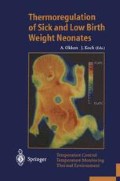Abstract
Thermal care of newborns and particularly low birth weight babies has become a hot topic during the past several years. This particular infant population is vulnerable to bacterial infections and because prodromal clinical signs are very unspecific, early detection of this severe disease state is of paramount importance for the prompt start of treatment [1–5].
Access this chapter
Tax calculation will be finalised at checkout
Purchases are for personal use only
Preview
Unable to display preview. Download preview PDF.
References
Kluger MJ (1992) Fever revisited. Pediatrics 90: 846–50.
Kovatch AL, Wald ER (1985) Evaluation of the febrile neonate. SemPerinatol 9: 12 – 19.
Lieu TA, Schwartz SJ, Jaffe DM, Fleisher GR (1991) Strategies for diagnosis and treatment of children at risk for occult bacteremia: Clinical effectiveness and cost-effectiveness. J Pediatr 118:21–29.
Baskin MN, O’ Rourke EJ, Fleisher GR (1992) Outpatient treatment of febrile infants 28 to 89 days of age with intramuscular administration of ceftriaxone. J Pediatr 120: 22–27.
Down SM, Mc Nutt RA, Margolis PA (1991) Management of infants at risk for occult bacteremia: A decision analysis. J Pediatr 118: 11–20.
Ogren JM (1990) The inaccuracy of axillary temperatures measured with an electronic thermometer. Am J Dis Child 144: 109–111.
Morley CJ, Hewson PH, Thornton AJ, Cole TJ (1992) Axillary and rectal temperature measurements in infants. Arch Dis Child 67: 122–125.
Childs C, Little RA (1994) Acute changes in oxygen consumption and body temperature after burn injury. Arch Dis Child 71: 31–34.
Herzog LW, Coyne LJ (1993) What is fever? Normal temperatures in infants less than 3 months old. Clin Pediatic 32: 142–146.
Brown PJ, Christmas BF, Ford RP (1992) Taking an infant’s temperature: Axillary or rectal thermometer? NZ Med J 105: 309–311.
Keeley D (1992) Taking infants’ temperatures. Forget the axilla- the rectum is better. BMJ 304: 931–932.
Anagnostakis D, Matsaniotis N, Grafakos S, Sarafidou E (1993) Rectal — axillary temperature difference in febrile and afebrile infants and children. Clin Pediatr 32: 268–272.
Keusch GT (1976) Fever. To be or not to be. NY State J Med 76: 1998–2001.
Mok Q, Bass CA, Ducker DA, Mcintosh N (1991) Temperature instability during nursing procedures in preterm neonates.Arch Dis Child 66: 783–786.
Voora S, Srinivasan G, Lilien L, Tsu EY, Pildes R (1982) Fever in full-term newborns in the first four days of life. Pediatrics 69: 40–44.
Osborn LM, Bolus R (1985) Temperature and fever in the full-term newborn. J Fam Pract 20: 261–263.
Klein JO, Marcy SM (1990) Bacterial sepsis and meningitis. In: Remington JS and Klein JO, Eds, Infectious diseases of the fetus and the newborn infant. WB Saunders pp 601–644.
Crain EF, Shelov SP (1982) Febrile infants. Predictors of bacteremia. J Pediatr 101: 686–689.
Rutter N (1986) Temperature control and its disorders. In: Robertson NR Ed, Textbook of neonatology, Churchill-Livingstone pp 148–161.
Messaritakis J, Anagnostakis D, Laskari H, Katerelos C (1990) Rectal-skin temperature difference in septicemic newborn infants. Ach Dis Child 65: 380–382.
Pomerance JJ, Brand RJ, Meredith JN (1981) Differentiating environmental from disease-related fevers in the term newborn. Pediatrics 67: 485–488.
Jackson JA, Petersen SA, Wailoo MP (1994) Body temperature changes before minor illness in infants. Arch Dis Child 71: 80–83.
Editor information
Editors and Affiliations
Rights and permissions
Copyright information
© 1995 Springer-Verlag Berlin
About this paper
Cite this paper
Messaritakis, J., Anagnostakis, D. (1995). Thermal Monitoring in Sick Neonates. In: Okken, A., Koch, J. (eds) Thermoregulation of Sick and Low Birth Weight Neonates. Springer, Berlin, Heidelberg. https://doi.org/10.1007/978-3-642-79934-1_9
Download citation
DOI: https://doi.org/10.1007/978-3-642-79934-1_9
Publisher Name: Springer, Berlin, Heidelberg
Print ISBN: 978-3-642-79936-5
Online ISBN: 978-3-642-79934-1
eBook Packages: Springer Book Archive

